#christian eisen
Text

he's being naughty
#hogwarts legacy#hogwarts legacy mc#christian eisen#hogwarts legacy screenshots#virtual photography#hogwarts legacy fandom#wip#hogwarts legacy male mc
17 notes
·
View notes
Text

The Wolf and its different meanings in Wolfs World:
The Wolf in Fables: The male Wolf Isegrim (Isen=Eisen= Iron ; Grim=Grien=Grin /snarl, but also Ironmask as in the Grimme of a helmet that protects the face ) is used as a symbol for the feudal baron: The Wolf is always hungry, always bad, always strong, always cruel, always devious but also always very stupid.
The Female Wolf Griermund (Grier=Gier=Greed, Mund= Mouth; But also Grier=Grinsen=Knurren=Grinning=Snarling) is the same by the matter that she is always hungry, always eating and very stupid. Nothing is enough for her, nothing can still her hunger. However, if the fable is from areas more eastern than the Wolf becomes like the fox and instead becomes instead of the hungry villian, more of a ambivalent trickster.
Wolf became out of Hunger a Robber and Murderer and as every Wolf-character in her Story (Which are surpisingly a lot) , she has to either live, indulge in or fight that hunger.
The Wolf in christian Fables: The Wolf is one of the Forms the Devil is taking, if he is not walking around as a huntsman.
The Wolf in the Ysengrimus: The Ysengrimus is a medieval fable in which the Wolf (Ysengrimus) is a stand in for the church (specifically the corrupted clergyman) , whom is critized for his greed/hunger and corruption and is in that story tricked (and eventually killed) by the Fox standing in for the normal people. The Ysengrimus is a critic on the Crusades and how those had been used to richen the Churchs on the costs of human life.
But also: Wolf specifically lives in Italy (northitaly for that matter, but still italy), so the Wolf has not as much as a negative image as there would be in (nowdays) middlegermany where she grew up. After all, the she-wolf is the mother of the roman empire and specifically Italy set itself appart from the franconian kings by claiming to be the heirs of the roman empire. Accordingly the She-Wolf is more a symbol of not only Motherhood and protection, but strenght . However, since Wolf as Werspinna is very much interpreted as a man by anyone interacting with her, she only seldomly can claim that symbol for her persona.
Wolfs therapreutic Tattoos are suppose to be inspired by Daunian Tattoos.
2 notes
·
View notes
Text
Out of the Bars, Into the Streets: An Interview By Eye Zen Presents
For our second post in our Deep Dive series, director Seth Eisen and I (Jax Blaska, research & production assistant) sat down to talk about the rise of gay bar culture in the early 1960s and how that contributed to the burgeoning gay liberation movement. The transcript of our conversation is below, along with links for further reading and historical context for certain happenings. Italicized segments below are pop-out context/deeper info on the topics we touched on. Enjoy!
Jax Blaska: What feels most important to you, when we think about (gay) bar culture in this time? How was this a shift from what came before?
Seth Eisen: The first thing that comes to my mind is the words: Safe space. And the other thing that comes to my mind is Romeo’s Pizzeria.
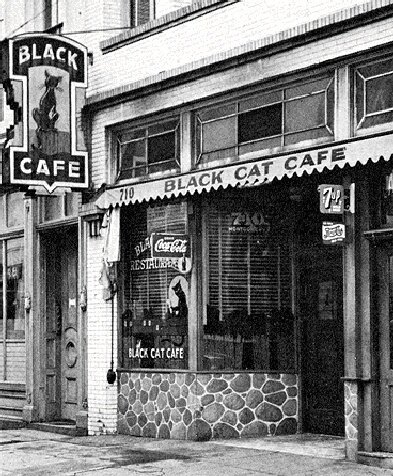
Image courtesy of https://www.foundsf.org/index.php?title=The_Black_Cat_Cafe
Romeo’s Pizzeria stood at 1605 Haight St., where Relic Vintage now lives. From 1964-1965, Romeo’s was the location of drag performer, activist, and eventual candidate for SF supervisor Jose Sarría’s operas. His performances’ typical location, the Black Cat Cafe on Montgomery St. in North Beach, closed that year after its owner had fought long and relentless legal battles in court for over 15 years.
I think it’s really interesting that that marked the transition in a way, because that year was really significant, in that the Black Cat closed after their long legal battle. Sol Stoumen, the proprietor, was a kind of incredible guy, I’m really fascinated by him. He was a Holocaust survivor, and a straight man, but his bar catered to all types of people — the Beats gathered there, older locals from the neighborhood, and of course, the gay crowd. There was so much police harassment going on, all about serving gay people. First of all, you could not be an out gay person as an owner of the bar, because if you’d ever been convicted of a crime against morality — which many people were, for soliciting or performing a lewd (homosexual) act — you were prohibited from running a bar. Women could not serve alcohol, (or even, in some places, legally enter a bar) so there was always a man working the bar. Even at Maud’s, the longest running lesbian bar up in Cole Valley, they had male bartenders, because that was the law. The ABC -- Alcohol Beverage Control board — had lots of control over how all these laws went, and then they were all tied together with Catholic, or Christian, politics and morality of the era, moving from the early 20th century into the mid 20th century. Mr. Stoumen took them to court a number of times, to the California Supreme Court, and he actually eventually won.
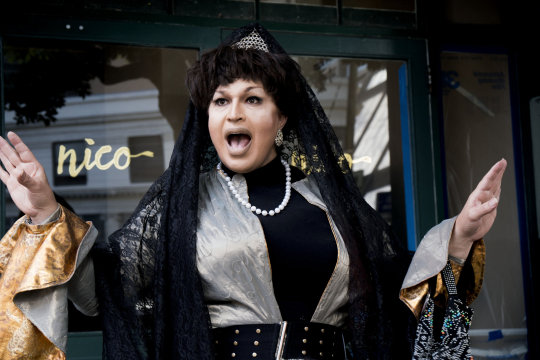
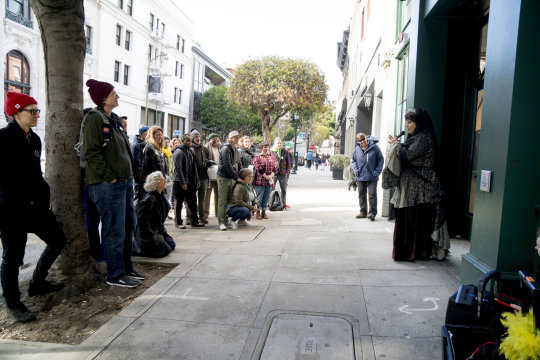
Landa Lakes performing as José Sarria outside Black Cat.OUT of Site.NorthBeach. Images courtesy of Chani Bockwinkle
But anyway, this is just to say, it’s an interesting thing that José’s stint at Romeo’s Pizzeria coincides with the closing of [the Black Cat]. Stoumen is such an important person, I think, in the fight for being able to serve queer people, and for queer people to be able to gather legally in a bar, because that was our safe space. And then there was this whole ring of police harassment and bribery — bribing the cops. So, regularly, a cop would come in, he’d give him the hundred bucks, or whatever it was, for that day, and then they would not bug them. And if not, there’s a whole bunch of arrests, and all that shit. This also brings in the beginnings of SIR, the Society for Individual Rights, and then also the Tavern Guild. They were one of the first gay activist organizations to gather power and the rights of queer bar owners and business managers to not be bugged.
JB: “The right to not be bugged,” I love that. And it’s interesting, because when we talk about queer liberation, and the birth of the more widespread gay liberation movement, often we talk about different uprisings that have happened in different bars. Obviously there’s Stonewall, but even before that, there’s Compton’s Cafeteria, in the Tenderloin. So it is really interesting to me that the bars and restaurants and clubs that served gay people become this rallying site from which to create a larger political movement. It starts as being just about — “just” about — “no, we have the right to gather and drink with our friends,” and then it becomes this larger fight for dignity.
SE: Yeah, the bars, that’s the first level of it. That’s a place where we could gather safety and power, because it wasn’t safe on the streets, being harassed, especially if you were non-binary or genderqueer in some way. And there was just so much blatant homophobia on the streets, and violence, and especially by the cops.
Which is what Stoumen was trying to fight. They basically forced him too close. Even though he went through years of legal battles. And won. But it wasn’t in time to save it. So then, moving forward, these bar owners band together, and José I think was pretty instrumental in developing the Tavern Guild. That was the first gay business association in the country, founded in 1962.
Yeah. Wow. It’s really telling — it’s not surprising, but it’s telling — that the first gay business association in the country is the Tavern Guild. That early solidarity is organized around equal access to bars. And it was based out of San Francisco.
Jose Sarría, nicknamed the Nightingale of Montgomery Street for his operatic performances at the Black Cat, was instrumental in developing the Tavern Guild, initially drawing together gay bar owners (and heterosexual owners of gay bars, like Sol Stoumen) to raise funds to pay for bail money and legal fees, like the ones Stoumen was facing for his long court battles. While it was too late to save the Black Cat, which closed in 1963 after its liquor license was revoked by the ABC and it could not survive by selling only food and soft drinks, the Tavern Guild did go on to become a crucial organizing arm of gay liberation in San Francisco. SIR and the Tavern Guild were closely intertwined allies: SIR would meet at alternating bars whose owners were members of the Tavern Guild, drawing business on typically slow nights, and Tavern Guild members would donate food and drink to SIR for its parties.

Image courtesy of https://www.foundsf.org/index.php?title=The_Black_Cat_Cafe

Image courtesy of https://revolution.berkeley.edu/tavern-guilds-beaux-arts-ball/ via the Berkeley Tribe
The most major event that the Tavern Guild would sponsor was an enormous Halloween drag ball, the first of its scale in the Bay Area, first held in 1963 at the Jumpin’ Frog on Polk St. At the third annual of these Beaux Arts Balls in 1965, Jose Sarría was named Queen. Declaring that he was already, had always been, a Queen, he then named himself Empress, and the Imperial Court system was born.
One really interesting thing is that at a certain point, after all this police brutality that was happening with the bars — I’m really fascinated by this straight police officer who the commisioner assigned to the gay community, and this was a real turning point.
Wow.
Yeah. So the history is pretty massive: there was a New Year’s party that was planned at the California Hall, on Polk St., and it was organized by a bunch of priests, including Reverend Cecil Williams, from Glide Memorial Church, who was a major activist in the scene, and Ted McIlvenna, a minister who later was a key figure in the San Francisco Institute for the Advanced Study of Human Sexuality. They planned this event so that this alliance between religious leaders and the gay community would prevent police from breaking it down, and assert that these people actually had the right to gather, and be there together. And then there was a huge raid, the cops did not do as they had promised, even one of the priests got arrested — anyway, that’s a whole other can of worms, but it’s an important moment because through that event, the failure of that event, came this desire and need for there to be a dialogue between the police department and the queer community. And it was, really interestingly, the priests that were leading this — who were also, you know, getting money from the government to help combat poverty at the time, so they were able to invest more into this.
I’m really fascinated by Elliot Blackstone, the police officer tasked as an intermediary between the gay community and the SF Police Deaprtment. He worked closely with the trans community, too, after a number of folks approached him about the brutality and violence they faced. He was an ally. He was like, “you can’t just go in and start arresting people randomly.” But of course, this is all tied to years and years of this police brutality. In all the neighborhoods that we were in — Polk Street, North Beach, the Haight, the Castro — the raids were just everywhere.
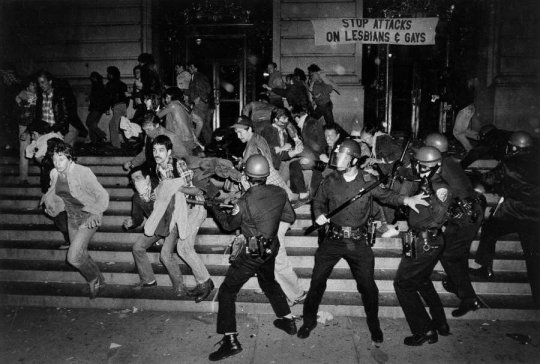
Image courtesy of https://projects.sfchronicle.com/2018/sf-pride-timeline/ via John Storey/The SF Chronicle
So all that stuff is really important to name. So then, once we move forward, going into the seven gay bars in the Haight, we can start to talk about the differences between them and the kind of individuality that was starting to happen. Maybe that was always the case, I don’t know, but like in North Beach, with the very early gay bars, there were always differences — lesbians went to one place, there was one place that was more touristy — but I think there was more nuance happening in terms of individuality in the gay community, and different kinds of queers. For example, we would note the gay hippie bars, the more activist lefty crowd, sometimes those mixed, and then the “clone” crowd.
The Seven Gay Bars of Haight Street:
Gus’s Pub. 1446 Haight St. Gus’s was frequented by motorcycle guys and leathermen. It served only beer and wine, no hard liquor, and its backyard was notorious for potsmoking, political discussions, and gay sex. Eye Zen friend/collaborator and filmmaker behind The Cockettes, David Weissman, told us in an interview that at first it didn’t occur to him that Gus’s was a gay bar because “I had never seen gay people that looked like that before” — that is, not effiminate or flamboyant, but masculine and tough. Lefties and hippies frequented as well. The wallpaper was a collaged collection of obscene comics and photos.
The Question Mark. 1437 Haight St. Now Trax, having changed its name in the early 80s. Directly across the street from Gus’s, The Question Mark brought a slightly higher-class, less politically-radical & leftist crowd. It was decorated with moose heads, and ironically, had a giant framed photo of Gus’s Pub displayed on the wall.
The I-Beam. 1748 Haight St. The I-Beam was the first big gay club in the Haight — filling a crucial niche, because prior to its opening, gay gathering places in the neighborhood were smaller and thus more secretive/private. But the I-Beam was big, and loud, featuring rock and punk bands like Siouxsie and the Banshees, Duran Duran and the Cult, as well as their packed Sunday afternoon Tea Dances, which provided an environment in which gay attendees were the majority. There was a $5 cover charge to get in, to which the hippies were initially opposed, as they felt it was an infiltration of “clone” gays from other parts of the city who were hopping on the bandwagon without being invested in the political and social ideals which gay hippies stood for. Nonetheless, the I-Beam was wildly popular, drawing up to 1000 people a night, and was a huge part of the “gay renaissance” of the Haight in the late 70s and 80s (the I-Beam opened in 1977). Its often drug-fueled dance parties, however, were the target of numerous sound complaints from neighboring businesses hoping to shut down this bastion of gay nightlife. The I-Beam closed in 1992, unable to remain competitive with the South of Market clubs which were permitted to go all night, as well as the devastation of the AIDS epidemic.
Bones. 1840 Haight St. Now, Milk Bar.
Cadillac. 1511 Haight St. A historical gay bar, then reopened as The Deluxe in 1978. Along with I-Beam, the Deluxe was one of the popular spots responsible for the “gay renaissance” of the neighborhood — it was a trendy spot to play pool and cruise.
Mauds. 937 Cole St. Owned by Rikki Streicher, Mauds was a familial gathering spot for San Francisco lesbians for over 20 years, until its close in 1989. Men were welcome — as bartenders, as California law prohibited women from pouring drinks. Streicher hosted holiday dinners for folks who didn't have family or homes to return to. For more, see the film Last Call at Mauds.
Bradley's Corner. 900 Cole St. Bradley’s Corner was a neighborhood piano bar for nearly 40 years, the last 20 of which were distinctly gay. Gays and lesbians gathered together there, along with military personnel from the Presidio — some of whom, no doubt, were included in the first categorization — and folks sang along to the piano and played pool. Around the corner from Mauds, Bradley’s also had a familial vibe: every Tuesday, spaghetti dinners were offered for 69 cents, while Wednesdays were "hat nights": "Wear a hat and pay 50 cents for bar drinks" reads an ad from the time.
Of these, only Trax (formerly The Question Mark) remains as a gay bar today.
So anyway, I think a key theme here is identity, post-Stonewall. Or, let’s just say, during the height of Gay Liberation. Because Stonewall is only one event. I love that — in the book we’ve been passing around [Smash the Church, Smash the State: The Early Years of Gay Liberation, a compilation edited by Tommi Avicolli Mecca] it names three events, pre-Stonewall — if you think about it, there’s Cooper’s Donuts in LA (1959), there was Dewey’s in Philadelphia (1965), Compton’s Cafeteria here in San Francisco, in the Tenderloin (1966), and then of course there’s the Stonewall (1969). And all of them had uprisings. And out of that comes gay liberation. That’s one of the factors. Not tolerating the harassment anymore, and asserting our rights. And so — Gay Liberation Front, the Bay Area Gay Liberation Front, the Society for Individual Rights, the Tavern Guild — all of these organizations are basically playing off each other, and they are the next generation after the Mattachine Society and Daughters of Bilitis. I think that’s important to mention: there’s starting to become this new awareness of what our identity was, that our identity was nuanced, and that there could be different places for different people to be.
Right, and not just — my understanding of Mattachine and Daughters of Bilitis is that they were pretty straight-laced, like, “gay people, they’re just like you,” march in Washington holding signs and wearing suits and dresses. Assimilationist, because there wasn’t really another option. But later, to really be able to assert — you know, Compton’s was primarily Black trans women and drag queens who initially fought back. There was someone, we don’t know who she was, but she throws her coffee in a cop’s face, and that apparently is what starts the uprising. Beginning to assert ourselves as queer people as having lots and lots of nuance and different types of desires and wants for community and liberation. Feels like a really crucial turning point.
Yeah, it is a crucial turning point. So, in the early 60s, our rights are changing, and these different bars are opening, in the Haight. There’s more nuance and more individuality, distinguishing one bar from the next, different versions of “gay” you could be. And out of that a kind of a revolution is happening.
This idea of gathering in community is obviously huge. Cannot be overstated.
Yeah, the gathering. And in terms of gathering, we also have the Golden Cask, which David Weissman [interviewed for the oral histories we gathered] mentioned was a big gay hangout and a very good restaurant, at 1725 Haight, so it was up a little higher, closer to the park. And then there was Blue Front Deli, which is still around, and it was a gay-owned business, and then Mommy Fortuna’s Cafe, which is where the Cockettes hung out. So I think between those places, there was a lot of gay gathering spaces, to be out and be ourselves.
I think this is a great backbone to the story about how gay bars played a role in gay political awareness and liberation. I’m also interested in how these gathering places, combined with the spirit of sexual revolution in the 60s, impacted folks more personally, on an individual level, in their sex and romantic lives.
So should we talk about sex?
Let’s talk about sex. My next question is: what changed for queer people with the sexual revolution of the 60s? What didn’t?
In terms of sexuality, I think when you’re repressed for long enough, living under some other morality system that you don’t subscribe to, that, I would think, would make us want to express ourselves in the most free & open way. To be in private spaces where we could love ourselves; where we could feel both safe and comfortable to be able to express ourselves sexually. “Gay is good” was a slogan José [Sarria] coined — this belief that we could be together in the ways that we wanted to, it wasn’t shameful, and it could be less hidden. As opposed to the ten years before, at these gay and lesbian bars in North Beach, when as soon as a cop walked in, you go and you dance with a person of the opposite sex. There’d be a word, or a code, flickering the light off and on, and there’d be this switching that would happen.
It’s a pretty interesting example of solidarity between the two communities. “Okay, neither of us want to be caught in this situation, so let’s pretend — let’s be beards, while the cops are here.”
Yeah. So I think with those newer freedoms, then you add LSD into it, once the 60s come around, and people are like, slithering around, and just wanting to make love to everything in nature. There’s pot, and mushrooms, and other drugs, to kind of help us get more into our bodies and appreciate what we have, who we are, physically, as social, sexual, spiritual beings.
I love that a lot. I love this idea that in some ways the drugs that became super widespread in the 60s may have helped the culture in general but in particular queer people to feel a part of their bodies. And that was not something to be ashamed of, or to push away, but to really embrace.
Yeah. I mean, of course there’s also the opposite of that happening — rampant alcoholism and addiction, with people holding so much shame and internalized homophobia that it’s turning inwards on ourselves. As seen in movies like Boys in the Band, which was originally a 1960s play. So I think both of these things are happening simultaneously: drugs freeing us, and drugs taking a hold of us. And the different gay groups are going in different directions. Mattachine splinters off, as you were saying earlier, and the assimilationists are going further in that direction, into fitting in, versus Harry Hay and many others who were creating [Radical] Faerie circles, gathering together and seeing us as more whole, healthy, “normal” and unique in our own way.
That’s really interesting, this idea of uniqueness, because I wonder if that’s something that’s shifting for the culture as a whole, and not just within the gay liberation crowd. I wonder if it’s something to do with the 60s, and 70s, the hippie movement, anti-Vietnam war, this desire to not be seen as part of the machine of the nation, and everything it stands for, all of the norms that it upholds. I can just imagine, all of these kids who were born shortly after World War II, and raised in that shadow, beginning to split off, and say, “no, I want to be an individual, it is not the goal to blend in, have a white picket fence and a suburban home that looks identical to my neighbors’.”
Yeah. Even as [Eye Zen contributor, Out of Site interviewee, historian] Michael Sumner pointed out, really acutely, that going back even further, into the first and second World Wars, that San Francisco was a stopping off point, for people at sea, and for military personnel coming through town. A lot of people saw this as a place where they could be singular people. Straight people as well, but there was more opportunity for homosocial spaces. So SROs [Single Resident Occupancies] have long been vital to San Francisco, and they created more of these homosocial spaces, where men could be living all together, in single rooms, because they were itinerant workers, so they’d be going out to sea, wherever they were called to duty. And then, when people were coming back from the war, they were like, “am I gonna go back to this conservative village in Indiana, or am I gonna stay in San Francisco?” So that’s how a lot of people chose to remain here, as they came through here, and they saw the potential for freedom, even though there was still a lot of danger. It goes all the way back to those times, and the connection to military then. And Jose [Sarría] is really part of this generation, he served in the military, he was discharged… Gavin Arthur is another one. He also served in the military. So anyway, that’s a whole other story. But I love how those generations kind of intersect.
[Eye Zen contributor, interviewee, historian and friend] Joey [Cain]’s been talking to me too, about the first Faerie gatherings, the first Sissy Circles — they were really an outgrowth of Gay Liberation Front circles. They were events where political strategizing would happen more casually inside people’s homes, where they would get together and talk about politics. And places like Gus’s were hotbeds for that crowd. And then they were meeting, at Arthur Evans’ place, and there were a bunch of these houses, where people were getting together and going “no, we’re not gonna tolerate this, we’re gonna fight back.”
This connects to Atascadero, which was a mental hospital where gay people would be sent. They were giving lobotomies to gay people, they were doing electric shock treatments, they were doing aversion therapy treatment, where they would hook up nodes to their penis and shock them when they were thinking about gay men, or gay sex, or whatever. These people were tortured, and many never recovered, physically or mentally. Activist Don Jackson wrote an article titled “Dachau for Queers” that ran in the Gay Sunshine Press about his experiences visiting “patients” — inmates — there.
Wow. Oof. That is… strong imagery.
So that’s what we’re pushing up against. We’re seeing that, and we’re going “no.” Cause a lot of people don’t know this, but people have to know that. It’s really important.
Yeah. I mean, I didn’t know that. Or when I think about that [torture], I think about it in rural areas, conversion camps… I don’t think about it in the Bay Area.
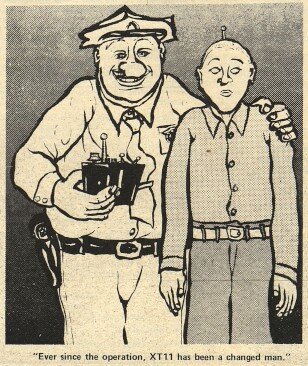
Image courtesy of https://voices.revealdigital.org/?a=d&d=BGJFHJH19730316.1.7&e=-------en-20--1--txt-txIN---------------1 via Los Angeles Free Press, “California runs a ‘Dachau for Queers,’” March 16-26, 1973
Ok, speaking of the Bay Area. What role did nature or public parks play in queer hippie life? Part of what I meant with this question is not just the free sex, cruising spots but also, how did proximity to nature impact the culture and the ways that people related to each other? Because that is something that is unique to San Francisco in terms of other major cities in America.
Well that’s interesting that you bring that up, because Sunday I was feeling obsessed, trying to find more stuff, and I was rereading the interview with Michael [Sumner], and that’s one of the major themes that he got into: that especially the Haight, nature was a really important thing. LSD played a part in that, acid being a drug that puts you in touch with your body and the environment, that you’re in this state of presence. And Michael also mentioned that there was a whole group of radical queers from the GLF who were regularly going to different spots in San Francisco. There are more areas of nature in San Francisco than there are in most urban environments — and also they were going up to Russian River. That was the big hangout spot. And as we moved into the ‘70s and ‘80s, that remained, and still remains, a really important haven for queers. During the AIDS pandemic, a lot of people were going there to die, and thought they were going to die there. It’s so hard to say “they,” because everyone’s story is unique, but I’ve heard many stories of people going there to die, and then the cocktails happened, and they survived, and they are still there. I know a handful of people, who I’ve visited there, people I’ve known over the years. And you know, there are events, and bars there, the whole scene. But yes, I think nature’s really important.
And then there was, of course, sex happening in Golden Gate Park, at the Windmills, down near the beach, which has historically been a well-known gay cruising spot. And then there are all these bathrooms, within the park. There’s one particularly, right near the buffalo, that I’ve heard was a big cruising spot. Cause like, where do you go? You have roommates, they don’t know you’re gay, where do you go to have sex? But Buena Vista Park was really developed. I mean, you can still walk through there, and see the pathways that were created in different places. More on the Eastern side, off the beaten path, you can still see these pathways where you can walk between bushes. It’s all been opened up now, they’ve cut back all the bushes so it would stop — because it was like, a gathering space, there’d be dozens and dozens and dozens of people there, you’d go there to cruise people, you’d bring people there, there was sex happening all over the place. And then there was, you know, Bobby’s Victorian.
Well, we have to talk about Bobby’s Victorian, because as you know, this is one of my favorite details of the entire project.
I mean, he’s a fascinating character, Bobby Kent — he played in Glide’s band, he performed with Sylvester, he was really there in the moment. More connected, it seems, than most, in an interesting and unusual way. Why are you fascinated by him?
For some of the similar reasons you mentioned. Multiple different people have mentioned him, to you, to us, being like, “Oh yeah, he was there. That was him also,” and I’m always fascinated by the types of characters who tend to find themselves amongst different communities. There’s also something about the physical history — the built environment of the neighborhood. The fact that he had this job restoring old Victorians — you know, I grew up in a Victorian house up in the Fillmore, and have a lot of nostalgia for those types of homes, a lot of appreciation for how specific and weird a lot of their quirks are. So the fact that one of his crafts — he was a musician, among other things as well — but one of his crafts was this very loving restoration of these homes, not because it was profitable, back then, but because otherwise they were going to be torn down, and because he thought that they were beautiful, and they shouldn’t be torn down. And then to go and be like, “okay, I’m going to take scraps from these job sites I’m working on and go build a Victorian treehouse in the biggest cruising area in the city, and make it, like, an orgy treehouse — ” I also love that. I wanna know — I mean, the cops burned it down one night? I want to know, were there people there, did they see? Was there a raid on the park in general and then the cops burned it down in protest, or was it kind of in secret, like, toss a lit cigarette in, and then boom? I mean, I don’t know. That’s just — one of the details I’ve latched onto in this project.
Yeah. I love talking about this shit with you, Jax. It’s been really fun.
I feel the same way!
*both laughing*
#Jax Blaska#Seth Eisen#Jose Sarría#Black Cat Cafe#Maud's#Stonewall Inn#Sol Stoumen#Cecil Williams#Ted McIlvenna#Gus’s Pub#Eye Zen#The Question Mark#The I-Beam#The Deluxe#Bradley’s Corner#Trax#Compton’s Cafeteria Riot#Cooper's Donuts Riot#Dewey’s Sit-in#Mattachine Society#Daughters of Bilitis#Gay Liberation Front#Queer#Revolution#Image#Interview#History#Frank Kameny#Boys in the Band movie#Film
2 notes
·
View notes
Link
David Coulthard hoopt dat er niet te voorbarig al conclusies worden getrokken.
0 notes
Text
0 notes
Text
A MUST READ!!!
More manipulative underhanded attempts by extremist Trump MAGA cult member conspiracy theorists to UNDERMINE AMERICAN CITIZEN 'VOTES' BEING LEGITIMATELY COUNTED IN THE COMING 2024 PRESIDENTIAL ELECTION in order to get dictator-wannabe Trump re-elected. 🙄
"In a basement event space in the Denver suburb of Parker, Tina Peters surveyed a crowd of Colorado Republicans last week and made an unusual pitch for why she should become chair of their beleaguered party: 'There’s no way a jury of 12 people is going to put me in prison.'
Peters was referring to her upcoming trial on seven felony charges related to her role in allegedly accessing confidential voting machine data while she was clerk in western Colorado’s Mesa County. The incident made her a hero to election conspiracy theorists but unpopular with all but her party’s hardest-core voters.
Peters, who condemns the charges as politically motivated, finished second in last year’s GOP primary for secretary of state, Colorado’s top elections position.
Now Peters has become part of a wave of election deniers who, unable to succeed at the polls, have targeted the one post — state party chair — that depends entirely on those hardest-core Republicans.
Embracing election conspiracy theories was a political albatross for Republicans in states that weren’t completely red last year, with deniers losing every statewide bid in the swing states of Arizona, Michigan, Nevada, Pennsylvania and Wisconsin. But the movement has focused on GOP state party chairs — positions that usually are selected by only dedicated activists and have the power to influence the party’s presidential nominating contest and some aspects of election operations, such as recruiting poll watchers.
'The rise of this dangerous ideology nationwide and the rise within party machinery are ominous,' said Norm Eisen, a prominent Washington lawyer and former ambassador who is executive chair of States United Democracy Center, which tracks election deniers. 'It’s an outrageous phenomenon.'
Kristina Karamo, a former community college instructor who lost her bid last fall to become Michigan’s secretary of state by 14 percentage points, won the chair of the Michigan Republican Party a week ago. She beat a fellow election denier, failed attorney general candidate Matthew DePerno.
In Kansas, Mike Brown, a conspiracy theorist who lost his primary bid for secretary of state, was named chair of the state party.
Peters is just one of multiple candidates for the Colorado position who have repeated former President Donald Trump’s lies that President Joe Biden did not legitimately win the 2020 election.
'We can’t just say, ‘Oh, it’s time to get over 2020 and be done with that,''said Aaron Wood, a self-described Christian conservative father also running for Colorado GOP chair, who organized a slate of candidates to take over the party’s top posts. 'Until I have 100% confidence that the election has integrity, I will not be done with that.'
The wave of election deniers follows a push by Trump during his administration to stock the roster of party chairs with loyalists, several of whom supported his attempt to overturn the 2020 election and remain in the White House. Of those, Kelli Ward, the chair of the Arizona GOP, did not run again and was replaced by another Trump loyalist, former state Treasurer Jeff DeWitt. In Georgia, chairman David Shafer has announced he won’t seek another term this June, amid scrutiny over whether he could be indicted for efforts to help Trump overturn the 2020 election.
As in most states, the new Georgia party head will be selected by leaders of local county parties. Many of those are Trump loyalists who also backed Shafer’s bid to overturn Trump’s 2020 loss in the state. But Republican Gov. Brian Kemp, who defied Trump’s request and easily beat a primary challenger last year backed by Shafer, has marginalized the state party, creating a parallel structure to raise money and turn out voters.
That’s an example of how the once powerful post of state party chair has changed.
'It used to be adjacent to public service, to be the state party chair, and now it’s something where you get to dunk on Democrats on Twitter,' said Robert Jones, a Republican pollster in Idaho.
In that state, Dorothy Moon, an election denier and former state representative who made an unsuccessful primary run for secretary of state, became the Idaho GOP chair last year.
Still, Eisen noted that state parties have important roles in appointing poll workers and poll watchers in many states. A perennial fear has been that conspiracists could fill those positions and disrupt elections, though that did not happen in 2022 despite a prominent conservative effort to find more poll watchers.
'Maybe the Karamos and the Browns and the Moons will implode,' Eisen said. 'There is a kind of incompetence that goes with this ideology. But it’s a concerning trend given the power these state parties have.'
Parties also have a major role in structuring their primaries. In Michigan, the party apparatus that Karamo now leads has the power to move its nominating contest to a closed convention, where activists select the winner.
'Donald Trump would love there to be a convention for Michigan’s delegates,' Jason Roe, the former executive director of the state party, said in an interview.
Ironically, Trump had endorsed DePerno, a lawyer who unsuccessfully sued to force a new count in 2020. Instead, Karamo, whom the former president had supported in her secretary of state race, won. She has described abortion as 'child sacrifice' and Democrats as having a 'Satanic agenda.'
Last wek, on the podcast of Trump adviser Steve Bannon last week, Karamo said Michigan was 'ground zero for the globalist takeover of the United States of America.'
In Colorado, many Republican strategists say they are prepared for Peters or another election denier to win the party chair position next month.
'People seem almost resigned that the party is going to fall into the hands of this crowd for the next two years,' said Sage Naumann, one of the operatives, who said usually a chair’s impact on elections is 'neutral,' but that could change.
'If they’re constantly making controversial statements, then they can be detrimental,' Naumann said.
The insurgent candidates running for Colorado’s chair argue things can’t get worse for the GOP in the state. Republicans lost every statewide race by double digits in November and have their smallest share of seats in the Legislature in state history.
The candidates for party chair claim the Colorado GOP has been too timid and needs to be more outspoken and conservative — a risky bid in a state that has been rapidly moving to the left. As part of that, they seek to restrict the primary to only registered Republicans, shutting out voters not affiliated with any party who have been eligible to participate. That would require overturning a voter-approved ballot measure, which activists failed to do in a lawsuit last year. They hope to have a better shot with the party chair’s support.
At the debate last week in Parker, former state Rep. Dave Williams said: 'It’s time we had a warlike leader who is going to go toe-to-toe' with Democrats.
Williams later added: 'Joe Biden is not a legitimate president.'
Only one candidate, Erik Aadland, a military veteran who unsuccessfully ran for Congress last year, cautioned about the election denier rhetoric. He noted that Democrats effectively used a tape of him questioning the validity of the 2020 election against him in his race. In an interview, he said specifically that he worried about Peters’ candidacy.
'It’s not healthy, the words we’re using, the rhetoric we’ve been using,' Aadland said. And, he added, 'I don’t think it’d be healthy to have a chairwoman under seven indictments.'
Peters, however, reveled in her national profile. She noted that she had just started a podcast that had 60,000 downloads on its first day and that she raised $250,000 to fund a recount in three days after the 2022 primary —a recount that confirmed her loss."
0 notes
Text
Over de Circulatietank:
Ook wel de Umlauftank of in de volksmond de Rosa Röhre (“Roze Pijp") genoemd.
Bevindt zich in Berlijn op Schleuseninsel.
Architect Ludwig Leo (1924-2012)
Leo realiseerde dit spectaculaire gebouw met de ingenieur Christian Boës.
Is een apparaat om te experimenteren met scheepsmodellen.
De "roze buis" vormt het watercircuit.
De kleuren onthullen de functie aan de waarnemer.
Zijn uitgangspunt in het onderzoek: een engagement met de toekomstige gebruikers van de gebouwen, zowel als fysieke wezens als als sociale actoren die samenkomen
Een gebouw als een assertief antwoord van een uitgesproken modernist op de vroege postmoderne vraag naar "complexiteit en tegenstrijdigheid".
Een hoogtechnologische machine, zowel monumentaal als mysterieus.
Men heeft zich vooral gericht op de technische eisen.

0 notes
Text
Over De Umlauftank of "Circulatietank”:
Ook wel in de volksmond de Rosa Röhre (“Roze Pijp") genoemd
Is een apparaat om te experimenteren met scheepsmodellen
uit Onderzoeksinstituut voor Waterbouwkunde
Zijn uitgangspunt in het onderzoek: een engagement met de toekomstige gebruikers van de gebouwen, zowel als fysieke wezens als als sociale actoren die samenkomen
In samenwerking met ingenieur Christian Boës
Een assertief antwoord van een uitgesproken modernist op de vroege postmoderne vraag naar "complexiteit en tegenstrijdigheid".
Hoogtechnologische machine
Technische eisen
De kleuren onthullen de functie aan de waarnemer
0 notes
Photo










Brightburn (David Yarovesky, 2019).
#david yarovesky#brightburn#brightburn (2019)#elizabeth banks#jackson a. dunn#brandon breyer#michael dallatorre#andrew s. eisen#peter gvozdas#patrick m. sullivan jr.#christian snell#kassandra deangelis#autumn steed
59 notes
·
View notes
Photo




(via President Dwight Eisenhower Prays Before Giving His First Inaugural Address January 20, 1953)
0 notes
Text
Dreamcasting Broadway: SUNDAY IN THE PARK WITH GEORGE







“White. A blank page or canvas. So many possibilities.”
Dreamcasting Broadway: Sunday in the Park with George
Jelani Alladin as Georges/George
Sara Bareilles as Dot/Marie
Sheryl Lee Ralph as Old Lady/Blair Daniels
Abby Mueller as Frieda/Harriet Pawling
Ann Sanders Nurse/Waitress (Old Lady/Blair Daniels u/s)
Beth Malone Yvonne/Naomi Eissen
Brittney Johnson as Celeste #2/Betty (Dot/Marie u/s)
Eric Anderson as Mr./Bob Greenberg
Hannah Solow Mrs./Billie Webster
Jesse L. Martin as Boatman/Charles Redmond
Jessica Keenan Wynn as Celeste #1/Elaine
John Treacy Egan as Louis/Photographer
Marcus Choi as Jules/Lee Randolph
Manu Narayan as Franz/Dennis
Milo Alosi as Soldier/Alex (Georges/George u/s)
Cicily Daniels as Museum Curator/Ensemble (Old Lady/Blair Daniels u/s, Frieda/Harriet Pawling u/s, Mrs./Billie Webster u/s, Nurse/Waitress u/s)
Lee Zarrett as Man with Horn/Museum Attendant/Ensemble (Franz/Dennis u/s, Soldier/Alex u/s, Mr./Bob Greenberg u/s, Louis/Photographer u/s)
Shannon O’Boyle as Museum Attendant/Ensemble (Yvonne/Naomi Eisen u/s, Celeste #1/Elaine u/s, Celeste #2/Betty u/s)
Tally Sessions as Second Soldier/Museum Attendant/Ensemble (Jules/Lee Randolph u/s, Franz/Dennis u/s, Boatman/Charles Redmond u/s, Mr./Bob Greenberg u/s)
Gwynne Wood as Swing (Frieda/Harriet Pawling u/s, Mrs./Billie Webster u/s, Celeste #2/Betty u/s)
Natalie Pilkington as Swing (Yvonne/Naomi Eisen u/s, Celeste #1/Elaine u/s, Nurse/Waitress u/s)
Rodrick Covington as Swing (Jules/Lee Randolph u/s, Boatman/Charles Redmond u/s, Soldier/Alex u/s, Louis/Photographer u/s)
Christian Danté White as Standby (Georges/George)
Shereen Ahmed as Standby (Dot/Marie)
#dreamcasting#dreamcasting broadway#sunday in the park with george#stephen sondheim#james lapine#jelani alladin#sara bareilles#sheryl lee ralph#abby mueller#ann sanders#beth malone#brittney johnson#eric anderson#hannah solow#jesse l. martin#jessica keenan wynn#john treacy egan#marcus choi#manu narayan#milo alosi#cicily daniels#lee zarrett#shannon o'boyle#tally sessions#gwynne wood#natalie pilkington#rodrick covington#christian danté white#shereen ahmed#broadway
4 notes
·
View notes
Text
life and life only (paul/victoria) (arguable gene/paul) (pg-13) (part 10 of ?)
part 1 | part 2 | part 3 | part 4 | part 5 | part 6 | part 7 | part 8 | part 9 | part 10 | part 11
Mermaid AU. Paul lives in isolation in a sunken ship with his sister, until a new mer comes by to see his ship, and he starts to reassess the human world. In this chapter: Paul and Gene's friendship progresses, and Paul watches Victoria's movie.
He learned a lot from Gene. Gene taught him more about Judaism than the snippets he’d figured out from the Eisens. For the most part, Gene didn’t even seem to think Paul was too odd for being so ignorant, just blaming it on his family being Reform Jews. Gene would’ve been unhappy to know that Paul was raised, if a little indifferently, on the mer religion, a combination of old mer and human traditions that hardly resembled Judaism. It took many years before Paul ever really got a handle on where the human aspects of mer beliefs came from, a highly uneven merging of Greek myths, indigenous religion brought mainly by the Iroquois and Cayuga, and the Christianity that had permeated New York for nearly three hundred fifty years.
Through Gene, he learned about human advances, too. Once, Gene slept with a girl who had a hearing aid, and Paul, fascinated, had kept asking Gene questions about it after the girl was gone.
“I’ve never seen one of those before.”
“Haven’t you been around any old people?”
“Not a lot of them.” He was getting excited. Why hadn’t Victoria mentioned anything like this before? “Was she always deaf? Did you ask her?”
“Why the hell would I ask her something like that? We were fucking, not telling our life stories.”
“Do you know how it works?”
“It amplifies sound.”
“Oh.” So she wasn’t completely deaf after all. The hearing aid just made everything louder. With no ear, and no hearing on that side, a device like that wouldn’t be of any use to him.
“You’re funny, Stan. I used to think you were fucking with me when you’d ask questions like that.”
He could feel himself flush. Gene was probably going to insult him. He tried to think of something acrid to say in response, but couldn’t get a word out.
“But I don’t think you are anymore. I don’t know anyone in Queens like you.”
“That’s not a compliment, Gene.”
“It is. It’s refreshing.” Gene cleared his throat. “You know, when I got to America, I’d never seen a T.V. before. I walked behind it, looking for the newscaster on the screen.”
Paul couldn’t suppress a small smile.
“I’ve never done that.”
“I hadn’t seen a grocery store before, either.” Gene seemed like he was about to trail off, a distant look in his expression. “I never knew there were so many foods at once anywhere. I couldn’t believe it. That’s what you remind me of.”
“A kid in the grocery store?”
“A kid who looks at everything like it’s brand new.” Gene cocked his head. “‘O, brave new world, that has such people in’t.’”
“What?” Paul’s eyes widened, prickles running up his arms. No way. No way in this world that Gene could possibly suspect him. Gene didn’t believe in anything supernatural, beyond God. Paul had been careful. He couldn’t have given himself away-- “What are you talking about?”
“The Tempest. Shakespeare.”
“I haven’t heard of it.”
“So much for your performing arts school.” Gene elbowed him, and Paul jerked back just slightly. “‘’Tis new to thee.’”
--
They formed a band not too long after. It didn’t last. Gene, Paul found, was able to worm his way into anything, including getting on other people’s records, and so the name that Victoria had given him ended up in the credits of some girl singer’s demos. It was a start, the both of them singing a couple choruses, but Gene didn’t want to only do session work. He wanted what Paul wanted. He wanted to be a star.
Gene used every resource he had. He’d appropriate the mimeograph machine at the Vogue office to print out band flyers. He wrote out his own glowing reviews of their band (when they had one) and would mail them out to whole scads of New York music execs. Paul would help, utterly fascinated at Gene’s determination. He wondered if that was ever what Victoria had done, building herself up through these menial means, or if her youth and talent and parents had done a lot of the propelling for her.
He was thinking less of Victoria these days, and more of Julia. He hadn’t tried to find her. He thought that Omar Medlin might have been able to pinpoint that commune she was living at. Her and her little baby girl. She’d have to be several months old by now. He wondered if she had the same dark curls as he and Julia. He wondered if she’d have an affinity for the sea.
He only told Gene about Julia in small snippets. The misframing of his human backstory meant that Gene really didn’t understand Julia’s situation at all. Without knowing that their parents were dead, without knowing about Paul’s ear, and the liability that was in the ocean, Julia seemed insane to Gene. Hateful for no reason whatsoever.
“I bet she’s manic-depressive,” Gene offered once, while they were sitting around in Paul’s cousins’ apartment, flipping through the newspaper, looking through the movie listings. He had taken two psychology courses, which he seemed to think made him an expert on human behavior. “When did she start running off?”
“When we were teenagers.”
“Was she ever on drugs?”
“No. Not that I know of.”
“Communes are crappy places to raise a kid. You and your parents need to find her, to take care of that baby.”
“Julia doesn’t want me finding her.” But he couldn’t tell Gene why. At this point, he didn’t care too much about all the lies he had to keep up on a daily basis, just to pass as human. But he did care about lying so much to Gene. Warping how Julia really was. Warping himself in the process. “Did you find something you wanna see?”
“Vanishing Point just opened.”
“What’s that about?”
“It’s a road movie. I think it’s like Easy Rider. The review’s shit.”
“Then why watch it?”
“I like shitty movies.” Gene loved movies in general. “Besides, look, there’s a lot of praise for the chicks here. Read this-- ‘The nicest thing about the movie is the women—not only Victoria Medlin and Gilda Texter, both beautiful in supporting roles, but--’”
“Victoria Medlin?”
“Yeah, Victoria Med--”
“From Hair?” Paul could feel his mouth twitch hard, lump forming in his throat. “And the shampoo commercials?”
“How the hell do you know who she is?”
“She was my girlfriend. She’s the one that left for California.” His voice was on the verge of wobbling. “She said she got a part in a movie. I-I guess that’s the movie.”
Gene looked at him closely. Paul thought he was going to scorn him, call him a liar, but he only offered up a question instead.
“Do you want to see it?”
He didn’t know if he really wanted to or not, but his head drooped into a nod before a word could come out.
“All right.” Gene traced his finger down the listings. “There’s a showing at five-thirty, seven….”
“Five-thirty.”
“Okay. I’ll buy your popcorn.”
--
His hands were sweating before he entered the theater. The previews and advertisements washed over him like sewage, and he stuffed himself on mechanical fistfuls of Gene’s popcorn. The opening credits rolled and he saw her name in bold capital letters. Fourth billing. Fourth billing was a good start. Fourth billing was worth moving across the country, to a place she hated. A bad movie could still be a good investment. It was all marketing. That was what Gene had said.
He couldn’t pay attention to the story at all. He was just waiting to see her face, blown up to ten times its size on the projection screen. He hadn’t seen her in nearly a year now. He would jerk every time he saw a blonde girl onscreen, only to realize after another glance that it wasn’t her at all. Hazily, he realized the main character was doing the same thing. Kowalski, that was his name. He was driving across the country. He was making a delivery. Something. Paul got the feeling it didn’t really matter. This wasn’t Patton. This wasn’t important.
He kept waiting. Gene was glancing at him sometimes, but mostly kept to himself, aside from polishing off what was left of the popcorn. The cars onscreen were chasing each other, speeding down those empty desert highways, horrible in their desolation-- was this California? This dry, yellow-brown place, full of faded, poor people? Paul wasn’t sure.
More waiting. He had almost thought she wouldn’t be there at all, before he heard her smooth, honeyed voice.
“I love you.”
He tensed. His hands found the armrests, gripping too hard. Victoria was there, her long blonde hair barely covering her breasts as she kissed Kowalski. Her hands roamed his chest the way they had once roamed Paul’s own, fingers sure and gentle. The waves were washing up on the beach as the scene changed, as she walked with Kowalski. She was playing a surfer, but that barely registered at first. He was only aware she was touching that man instead of him.
“I love this. I love your scar. You hate it, but I love it.”
“No, I don’t hate it.” Kowalski. “I just hate what it means.”
“What does it mean?” And she kissed his chest and said something that might’ve been profound, murmuring the words against his body.
(i love you)
(i love this)
(i love--)
The words she’d never said to him, she was saying to that man. Touches he’d only shared with her, she was sharing with him. For a role. For a part. Paul wanted to throw up.
He had no claim to her anymore, and he knew it, but he couldn’t help himself. Every moment she was onscreen, he felt sick and angry. Defiled. He knew it wasn’t reasonable. When she’d played Sheila, her character had a boyfriend. But it felt different now. Sharing this all across the country, sharing a part of herself that he’d only seen in those soft, private moments in her bedroom-- made him feel lost.
Victoria told Kowalski she’d make another wave, walking out past the shoreline, and then she was gone. The screen flashed briefly with a newspaper death notice. A drowning.
(who ever heard of a mer drowning)
And then the flashback ended, Kowalski back on the road. That was all he saw of her, all that her fourth billing had merited her. She had moved all the way to California to only spend two minutes on the screen.
He didn’t remember the rest of the movie. He just filed out with Gene as the end credits rolled, Gene, who eventually patted him on the shoulder. He kept expecting Gene to say something smart, but Gene said nothing at all.
“You believe me now, right?” Paul said finally, stepping onto the filthy sidewalk. California with its browns and yellows; New York with its grays. It was all the same. All grotesque and human and useless. “You never thought I had a ma-- a girlfriend at all.”
“I believe you.”
“I’m never gonna be with her again.” The words kept spiralling out. “Gene, did you see her, did you see her with him-- touching him, she… she can’t--”
“Stan, it’s just a part.”
“You don’t understand. Victoria’s, Victoria’s my only--”
“I know. You’re gonna have others.”
“Don’t say that. I won’t. Not like her. Not ever like her.”
Gene’s face was unreadable, and he shook his head.
“Stan, let me walk you home.”
His eyes watered. He shoved at them with the back of his hand, then blinked hard.
“Don’t call me that anymore.”
“What do you want to be called?”
“Paul. L-like I put on that chick’s demo. Call me that. I-I never can pronounce Stanley right anyway.” He was rambling, and he couldn’t stop himself. Anything to take that image of her away, that image he was sure he’d never see again. “I got a lisp. I, I have it at home, too, in the wa-- I can’t--”
“C’mon, Paul,” Gene said quietly, slinging one arm around his shoulders as they walked, there in the stale chill of that March evening, back to the obscurity of his cousins’ apartment.
4 notes
·
View notes
Note
“Stop calling me a grinch! I’m not even Christian.” from Eisen to Victor
Victor laughs because Eisen clearly doesn't understand a compliment when one is paid. He bumps shoulders with the other man and shoves a mug that is more bourbon than cider. Doesn't he get it? It's an honorific. It's a badge to wear proudly. Victor certainly does.
"As the newest member to the Grinch Club," he continues, "of Non-Christians, Heathens, and Godless Assholes, you get to make the toast."
He grins. Does Eisen really think Victor celebrates Christmas? He looks around the barren laboratory - the closest thing to cheer being the mug between his hands that says "Never Trust An Atom: They Make Up Everything" in rainbow font - and wonders at what point the other man will get it. This isn't a Christmas party or an intervention or something: it's a show of solidarity.
#genrcsavvy#;;a mad genius | {victor frankenstein}#.002 | modern#x. asks#x. meme response#;;ic | {victor frankenstein}#((Victor 100% gathers up his other non Christian friends to get wasted and avoid holiday cheer and ESPECIALLY snow))
2 notes
·
View notes
Text
My OCs’ Etymology
This list will break down the etymology and origin of the names of my twst ocs. This may be updated with new ocs so this will be tagged “names” for you to find.
Frederich Brunnen (Snow White’s Prince):
Some documents in the Disney archives call the prince “Frederick”, although it’s usually accepted that the prince’s name is Florian.
“Brunnen” is German for fountain, referencing the wishing well where Snow White and the prince first meet.
Charmant Fête (Prince Charming):
“Charmant” is French for Charming.
“Fête” is French for party or festival, referencing the ball where Cinderella and the prince meet.
Verre/Ash Trein (Cinderella):
“Verre” is French for glass.
In the original story, Cinderella is given her name because she sleeps by the fireplace and gets cinders and ashes on her face.
Faith Fairwife (Fairy Godmother):
The Fairy Godmother says to Cinderella, “If you'd lost all your hope, I couldn't be here.” This suggests that the Fairy Godmother is the physical manifestation of Cinderella’s hope.
Jour Rosamund (Aurora):
In the original Sleeping Beauty by Charles Perrault, Sleeping Beauty has two children with the prince, who are named Aurora (Dawn) and Jour (Day).
In some translations of Grimm’s Sleeping Beauty, the princess is named Rosamund.
Florimund Désiré (Prince Phillip):
In the Sleeping Beauty ballet by Tchaikovsky, where the Disney version takes all its music from, the prince is named Désiré, but is also sometimes named Florimund.
Edward Colins (Prince Eric):
It is theorized by historians that Hans Christian Andersen, the author of The Little Mermaid, based the story on his unrequited love for a man named Edvard Collin.
Rielle Sidon (Ariel):
Sidon is short for Poseidon, Greek god of the sea.
Horatio Crustacea (Sebastian):
In the Octavinelle chapter, there is mention of a commemoration picture of a court musician named Horatio in the Museum.
Crabs belong to the aquatic group Crustacea.
Breaker Guppy (Flounder):
Originally, Ariel was supposed to have a pet dolphin named Breaker, who was eventually replaced by Flounder.
Ariel mockingly calls Flounder a “guppy”.
Bête Villeneuve (Beast):
Bête is French for beast.
Gabrielle-Suzanne Barbot de Villeneuve was the original author of Beauty and the Beast.
Beau Belmont (Belle):
Both “Belle” and “Beau” are French words for beauty.
Jeanne-Marie Leprince de Beaumont is the author of the second and more famous version of Beauty and the Beast, although I changed Beaumont to Belmont because Beau Beaumont sounds repetitive and Belmont has “Belle” in it.
Jean Candélabre (Lumiere):
Jean Cocteau was the director of the 1946 film Beauty and the Beast, which was one of the inspirations for the Disney version.
Candélabre is French for Candelabra.
Domo Cocteau (Cogsworth):
Cogsworth is the majordomo of the Beast’s castle.
Jean Cocteau was the director of the 1946 film Beauty and the Beast, which was one of the inspirations for the Disney version.
Badr Al-Asim (Jasmine):
Badroulbadour is the original name of the princess from Aladdin.
Mustaph Shahrzad (Aladdin):
In the original story, Aladdin’s father is a tailor named Mustapha.
Aladdin is part of the collection 1001 Nights, which is narrated by the queen Scheherazade, sometimes spelled Shahrzad.
Jinn Djinn “JinJin” (Genie):
The Arabic word for genie is “Jinn”, sometimes romanized as Djinn.
Chase Emeralda (Tiana):
Tiana was inspired by the famous chef Leah Chase.
The Princess and the Frog is partially inspired by the book The Frog Princess, where the princess is named Emeralda.
Heinrich Eisen (Naveen):
The story of the Frog Prince is also sometimes called “Iron Henry”.
Eisen is German for iron.
Maddy Pouffe (Lottie):
Maddy doesn’t actually mean anything, Lottie just kinda looks like a “Maddy”
Pouffe is derived from “poof” and “La Bouff”, Lottie’s surname.
Mei (RSA MC):
Mei alludes to the word “me” just like Yuu alludes to the word “you”.
Perralt (RSA Grim)
Grim alludes to the fairytale authors The Brothers Grimm, and Perralt alludes to another fairytale author called Charles Perrault.
Rampion Bellflower (Rapunzel):
Rapunzel is actually the name of a plant, whose other name is rampion bellflower.
Hua Ming (Mulan):
In the original story, Mulan’s surname is “Hua”.
Ming starts with an M and rhymes with Ping, Mulan’s male disguise.
Po Waialiki (Moana):
In old drafts of Moana, Te Ka’s name was “Te Po”.
In old drafts, Moana’s last name was Waialiki.
Magnus O’Whisp (Merida):
Magnus alludes to Merida’s horse, Angus, and starts with an M.
O’Whisp alludes to the Will O’ the Wisps from Brave.
Kai Snow (Elsa):
Elsa is based on the character Kai from The Snow Queen, who is taken away by the Snow Queen and whom Gerda has to save.
Gerda Snow (Anna):
Gerda is the protagonist of The Snow Queen and goes on a journey to save her best friend Kai from the clutches of the Snow Queen.
Robber Reyne (Kristoff):
Kristoff is based of the Robber Girl from The Snow Queen.
“Reyne” alludes to “rein”.
Roi Heart (King of Hearts):
Roi is French for king.
Kore Despoina (Persephone):
Sometimes Persephone is named “Kore” meaning “maiden”.
Another alternate name of Persephone is “Despoina” meaning “the mistress”. Also, in an ancient Arcadian cult dedicated to Demeter and Persephone, they were collectively referred to as the Despoinai, the mistresses.
Ceres Despoina (Demeter):
Persephone’s mother was Demeter, whose Roman name was Ceres.
In an ancient Arcadian cult dedicated to Demeter and Persephone, they were collectively referred to as the Desponai, the mistresses.
Saturn Shroud (Kronos):
In Greek mythology, Hades’ father was Kronos, king of the titans, whose Roman name was Saturn.
Opal Shroud (Rhea):
In Greek mythology, Hades’ mother was Rhea, queen of the titans, whose Roman name was Ops.
Carabosse Draconia (Malleus’ grandmother):
In Tchaikovsky’s Sleeping Beauty, the evil fairy is named Carabosse.
Snowdrop Rosehearts (White Queen/Riddle’s dad):
Alice has a cat named Snowdrop.
35 notes
·
View notes
Text
#discoveringaragón No.7: Ruinas romanas Zaragoza
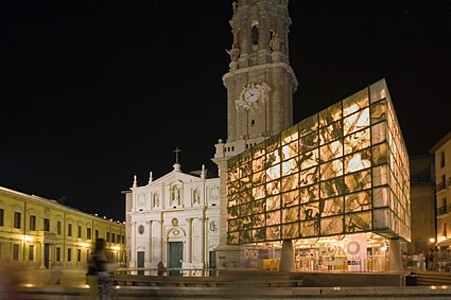
Caesaraugusta - une ville au bord du fleuve Ebro, fondée par les légions romaines IV Macedonica, VI Victrix et X Gemina. Deux millénaires ont passé depuis, mais ses empreintes sont toujours (plus ou moins) visibles - si on sait où chercher. Pour les visiter je conseille prendre le billet de 7€/5€, qui permet entrer dans les quatre musées de la Route Caesaraugusta. Pour seulement 2€ en plus, on peut aussi entrer dans le musée de Pablo Gargallo, qui est digne d’un post tout à lui. Le billet est valable jusqu’à la fin d’année depuis la date d’achat. Les musées sont, sans ordre particulier:
Caesaraugusta - eine Stadt am Ufer des Flusses Ebro, gegründet von den römischen Legionen IV Macedonica, VI Victrix und X Gemina. Zwei Jahrtausende sind seither vergangen, aber ihre Spuren sind heute noch (mehr oder weniger) deutlich zu sehen - wenn man sie zu finden weiss. Um sie zu besichtigen empfiehlt sich das Kombiticket um 7€ bzw 5€, mit dem man Zugang zu allen vier Museen der Ruta Caesaraugusta hat. Und um nur 2€ mehr kommt man auch ins Museo Pablo Gargallo, das einen Blogeintrag für sich verdient. Dieses Kombiticket ist bis Ende des Jahres ab Ausstellungsdatum gültig. Die Museen sind, in keiner besonderen Reihenfolge, folgende:
Caesaraugusta - una ciudad en la orilla del río Ebro, fundada por las Legiones IV Macedonica, VI Victrix y X Gemina. Dos milenios más tarde, sus huellas son aún (más o menos) visibles, si uno sabe dónde buscar. Para visitarlas, os aconsejo el billete combinado de 7€/5€, que permite acceder a todos los museos de la Ruta Caesaraugusta. Con 2€ más se puede entrar también en otro museo del Ayuntamiento, el Pablo Gargallo, que se merece su propia entrada en el blog. Este billete combinado es válido hasta el final del año a partir de la fecha de compra. Los museos son, en ningún orden especial, los siguientes:
Termas Públicas
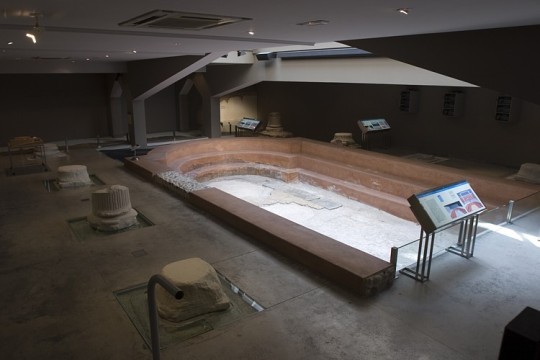
Il ne reste que très peu des thermes publics: quelque morceau d'escalier, des carreaux et des restes des latrines publiques sur lesquelles l’édifice énorme avait été construit. Cependant, on sait que les constructeurs avaient pris comme exemple les thermes de Pompéi, ce que est expliqué dans le video montré chaque demi heure. Malheureusement, le vidéo est qu’en Espagnol, mais toutes les explications autour des autres objets viennent aussi en français, anglais et je crois aussi allemand.
Von den Thermen ist von allen römischen Sehenswürdigkeiten am wenigsten erhalten geblieben. Was einst eine riesige Anlage sein musste ist heute nur noch ein Stückchen Treppe, etwas Fliesenboden und die Überreste der öffentlichen Latrine, auf denen die Thermen gebaut wurden. Allerdings weiss man, dass sie dem Vorbild der Thermen in Pompeji folgten, und im Video welches jede halbe Stunde gezeigt wird, wird das eindrücklich erklärt. Leider sind alle Videos nur auf Spanisch zu sehen, die Erklärung zu den verschiedenen Ausstellungsstücken gibt es aber auch auf Englisch, Französisch und ich glaube sogar Deutsch.
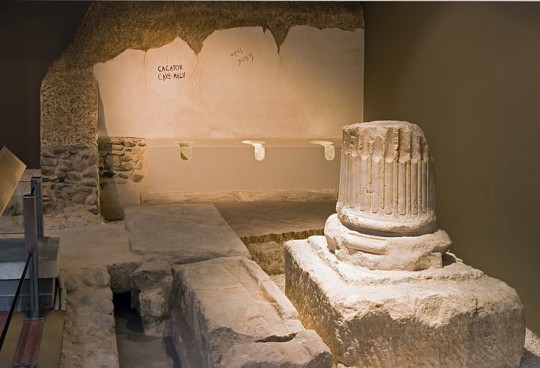
De todos los monumentos visitables, las termas son el peor conservado. Lo que debería ser antiguamente un edificio enorme es hoy en día un poquito de una escalera, alguna baldosa y los restos de las letrinas públicas sobre las cuales las termas fueron erigidas. No obstante, se sabe que fueron construidas con las termas de Pompeya como modelo. Este hecho y otras curiosidades son explicadas de manera muy visual en un video que se muestra cada media hora. Desafortunadamente, todos los videos están solo en español, pero las explicaciones de los diferentes objetos expuestos también están en inglés, francés y creo que hasta en alemán.
Foro Romano
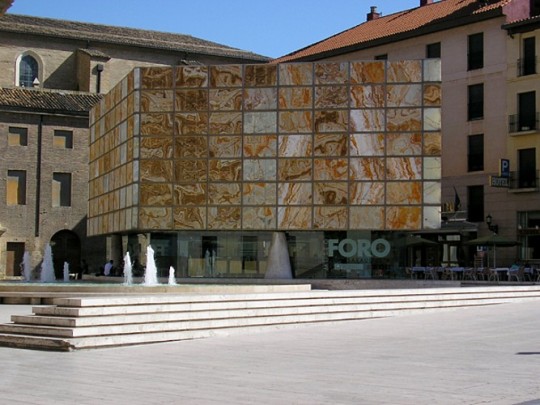
Le forum se trouve quelque mètre en dessous de ce qu'est aujourd’hui la Place de la Seo. Il fut découvert qu’en 1988. La place principale de Saragosse n’a presque pas bougé pendant les derniers deux millénaires. Ce musée est très impressionnant, car on peut marcher dans les anciens égouts, observer les marques des planches en bois utilisés pour construir les murs et voir des vraies conduites d’eau en plomb, une chose très rares car presque toutes ont été fondues plus tard. On apprend aussi beaucoup sur la vie quotidienne et les activités du forum.

Das Forum befindet sich einige Meter unter dem, was heute die Plaza de la Seo ist. Es wurde erst 1988 entdeckt. Der Hauptplatz von Zaragoza hat sich also in zwei Jahrtausenden ein bisschen nach rechts und nach oben verschoben. Dieses Museum ist sehr beeindruckend, da man durch die Abwasserkanäle durchmarschieren kann, die Abdrücke der Holzplatten sehen kann mit denen die Mauern gebaut wurden und sogar ein echtes römisches Wasserrohr aus Blei bewundern kann, was sehr selten ist, da sie später meistens eingegossen wurden. Ebenfalls erfährt man hier viel über den römischen Alltag und die Aktivitäten im Forum.
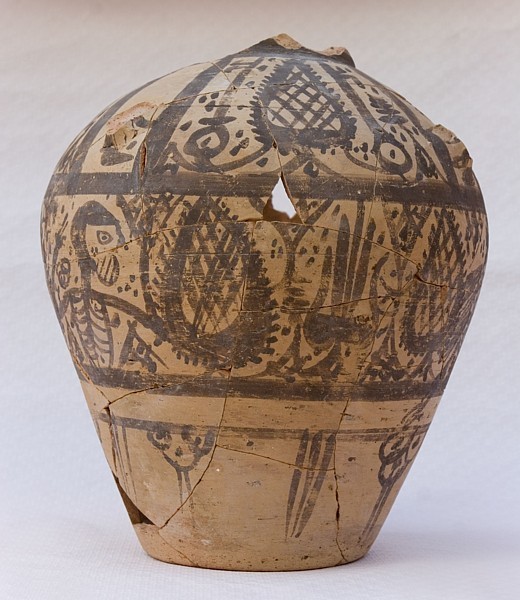
El foro romano se encuentra unos cuantos metros bajo lo que hoy en día es la Plaza de la Seo. Es curioso pensar que la plaza principal de Zaragoza se ha movido sólo unos metros hacía arriba y a la derecha en dos milenios. Este museo es muy impresionante, ya que se pasa por las antiguas cloacas, se pueden ver las marcas de las tablas de madera utilizadas para formar las paredes e, incluso, observar un tubo de agua de plomo romano, muy poco habitual ya que en la mayoría de los casos fueron fundidos más tarde para reutilizarlos. Aquí también se aprende mucho sobre el día a día en la época romana y las actividades que ocurrían en el foro.
Puerto Fluvial

Contrairement à la majorité des autres villes romaines, le forum de Saragosse se ne trouve pas dans le centre géographique de la ville, mais à côté du fleuve - à cause du port. De septembre à mai, toute type de marchandise était transporté vers Tarragona, le port de la péninsule ibérique le plus important: du bois des Pyrénées, du blé et du fer. Après, au retour, les matelots devaient souvent tirer les bateaux qui transportaient du vin italien, des toiles précieuses et autres friandises de luxe. L’Ebre était un fleuve sauvage, impétueux, mais une toise dans l’intérieur du musée montre que les deux derniers débordements qui ont dévasté Saragosse pendant le dernier siècle n’auraient pas affecté le forum. Ils n’étaient pas idiots, les romains.

This is how wood was transported down the river in the pyrenees, until not long ago! © Pepe Bescós
Im Gegensatz zu anderen römischen Städten befand sich das Forum in Zaragoza nicht im Zentrum der Stadt, sondern gleich neben dem Fluss - des Hafens wegens. Von September bis Mai wurden auf dem Fluss alle möglichen Waren in Richtung Tarragona, dem damals wichtigsten Hafen der iberischen Halbinsel transportiert: Holz aus den Pyrenäen, Getreide und Eisen. Flussaufwärts mussten die Schiffe oft gezogen werden; diese transportierten teuren Wein aus Italien, wertvolle Stoffe und Leckereien. Der Ebro war ein sehr wilder und unbeugsamer Fluss, aber Anhand einer Messlatte im Museum kann man sehen, dass beide schweren Hochwasser die Zaragoza im letzten Jahrhundert erlitt, dem römischen Hafen nicht geschadet hätten. Waren halt gscheite Leut.
Que el foro de Zaragoza no se encontrara en el centro de la ciudad, algo habitual en muchas otras ciudades romanas, sino en la orilla del río, era debido a la importancia del puerto fluvial de la ciudad. De Septiembre a Mayo se transportaban todo tipo de mercancías hacia el puerto de Tarraco (Tarragona), uno de los más importantes de la península ibérica. Desde madera de los Pirineos hasta trigo y hierro. De vuelta, los barcos tenían que ser tirados muchas veces por la tripulación. Transportaban vino caro desde Italia, telas preciosas y otros productos de lujo. El Ebro era un río muy impetuoso y salvaje, pero gracias a una regla graduada situada en el museo se puede ver que ambas inundaciones que devastaron Zaragoza en el siglo pasado no hubieran dañado el puerto. Gente lista, estos romanos.
Teatro Romano
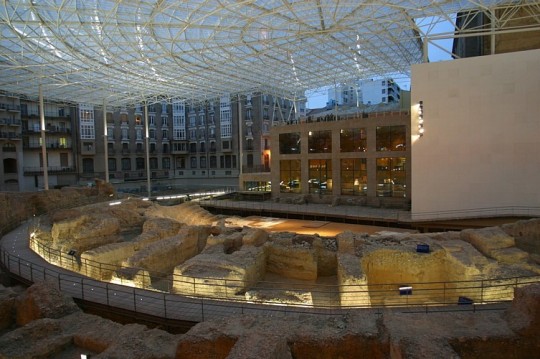
Le musée du théâtre est sûrement le plus impressionnant, car c’est le monument le mieux conservé. Construit au 1er siècle a.C, il a été abandonné déjà au 3ème siècle a.C. Ses matériaux ont été utilisé consécutivement par les musulmans, les juifs et les christians. Il fut découvert que pendant les années 70! Le musée autour du théâtre est sûrement le plus intéressant, car il couvre tout son histoire et conte aussi des vies quotidiennes des musulmans et juifs qui vivaient dans cette zone. Aujourd’hui on organise de nouveau des concerts ici.
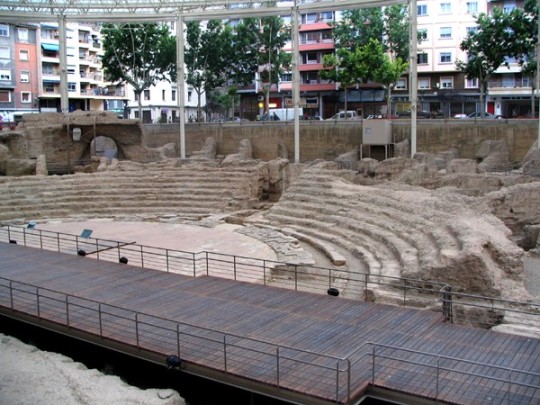
Das Amphitheater ist wohl die beeindruckendste Ausgrabungsstätte, da es am besten erhalten geblieben ist. Es wurde erst in den 70er Jahren ausgegraben! Gebaut wurde es im ersten Jahrhundert nach Christus, aber bereits im 3. Jahrhundert dem Verfall überlassen. Muslimische, jüdische und christliche Gebäude wurden dann aus dem Material gebaut. Das Museum rund um das Theater ist auch das historisch am Interessantesten, da es das Theater durch seine gesamte Geschichte zeigt. Angefangen mit den Theaterstücken die dargestellt wurden, über den Alltag der Muslimen und Juden die auf dem Gelände wohnten bis hin zur Ausgrabung. Heutzutage finden auch wieder Konzerte im Theater statt.

El Anfiteatro es probablemente el monumento más impresionante de época romana. Es realmente grande! Sorprendentemente, a pesar de su tamaño, fue descubierto en el año 1972. Se construyó en el primer siglo d.C., pero en el tercer siglo d.C. dejó de funcionar y lo abandonaron. Después de mucho tiempo abandonado, con sus piedras fueron construidas casas musulmanas, judías y cristianas. El museo del teatro es, históricamente hablando, el más interesante, ya que acompaña al teatro a través de todos los siglos de su historia y nos cuenta desde su uso romano, pasando por las vidas cotidianas de los Musulmanes y Judíos que vivían en esta zona hasta el descubrimiento y la excavación del monumento a finales del siglo XX. Hoy en día se vuelven a organizar conciertos en el teatro.

All pictures (except mine obviously) are from the photo archive of the city of Zaragoza.
1 note
·
View note
Text
Mundartliteratur sollte endlich wieder erforscht werden!
Christian Schmid begründet in einem Gespräch mit berndeutsch.ch, warum er sein neues Buch im Untertitel «E Chiflete» nennt, eine Streitschrift.
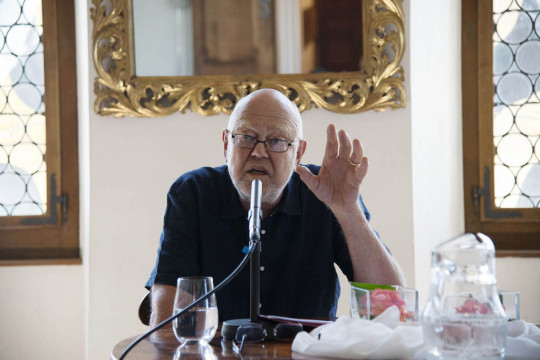
Christian Schmid. Foto: Ute Schendel.
berndeutsch.ch: In Ihrem kürzlich erschienen Buch «Häbet nech am Huet! E Chiflete» werfen Sie Deutschschweizern Sprachnarzissmus vor: Die Berner finden nur Berndeutsch schön, die Bündner nur Bündner Dialekt. Ist das nicht natürlich? Was hat Sie so in Rage gebracht, dass Sie mit dem Buchtitel gleichsam vor einer Katastrophe warnen?
Christian Schmid: Was ich mit dem Titel sagen wollte: Ich sehe zwar keinen Weltuntergang kommen, wohl aber eine gewaltige Veränderung der Welt, die uns gleichsam den Hut vom Kopf jagt. Die Strukturveränderungen, die gerade passieren, können wir noch gar nicht absehen…
Sie beziehen den Titel also nicht nur auf die Mundarten, sondern auf unsere Epoche generell?
Eindeutig. Und ja, auch ich finde es natürlich, dass man die eigene Mundart liebt, doch dieser Liebe fehlt heute das Fundament. Man spricht nicht mehr darüber, was gute oder weniger gute Mundart sei, was für Veränderungen wir wollen oder nicht wollen. Im Anschluss an die «Modern-Mundart»-Bewegung [nach 1968] debattierte man noch intensiv über die Mundart, publizierte auch viel. Seit dreissig Jahren herrscht hier Funkstille. Das ist es, was ich kritisiere, was mich wütend macht.
Sie schreiben, die Deutschschweizer und ihre Mundarten müssten kämpfen, müssten päägguhäärig sein können, wenn das Regionale nicht unter einer grossen Monokulturdampfwalze verschwinden solle. Was verstehen sie darunter?
Mundarten sind Kleinsprachen. Sie haben die übermächtigen nationalen und internationalen Sprachen neben sich, die es früher in dieser Dimension niemals gab. Erneuern können sich die Mundarten heute nur noch durch Anleihen aus den starken Nachbarsprachen: Alle Wörter, die neu in den schweizerdeutschen Mundartwortschatz einfliessen, kommen aus dem Standarddeutschen oder dem Englischen. Das verstehe ich unter Monokulturdampfwalze. Wenn wir aber «Kartoffle» und «Träppe» und «Träppeschtuefe» sagen – ist das dann noch Mundart? Aus meiner Sicht nicht. Ähnlich wie den Mundarten ergeht es im Übrigen auch der deutschen Standardsprache. Diese läuft Gefahr, den Anschluss an Entwicklungen vor allem in den Naturwissenschaften zu verpassen, weil die gesamten massgeblichen Publikationen in diesem Bereich auf Englisch geschrieben sind.
Gibt es nicht auch Mundartwörter, die z.B. in der Jugendsprache eine Renaissance erleben – oder interessante Neuschöpfungen? Wir hätten da Beispiele…
Ja, freilich, doch die Jugendsprache ist kurzlebiger, als man sich das einst gedacht hat. So wurde z.B. der Ausdruck «uf ne Trip gaa» sogar ins Idiotikon aufgenommen. Heute verwendet ihn kaum jemand mehr.
Es fehlt an wissenschaftlich soliden Biografien
Mundart sei nicht Gegenstand universitärer Forschung, schreiben Sie. Zürich, Basel, Freiburg und auch Bern haben aber doch Lehrstühle für Dialektologie, an der ETH hat Prof. Roland Ris schweizerdeutsche Dialektologie erforscht?
So generell habe ich es nicht formuliert. Die Dialektologie befasst sich durchaus mit den Mundarten, aber die Literaturwissenschaft nicht: Vor kurzem eliminierte das Deutsche Seminar der Uni Zürich doch tatsächlich sämtliche Mundartbände aus seiner Bibliothek!
Was müssten die Universitäten anders machen?
Ich stelle fest, und das macht mich fast wahnsinnig, dass unsere Mundartliteratur nicht aufgearbeitet ist. Seit der Mundartliteraturgeschichte von Otto von Greyerz aus dem Jahr 1924 gab es nichts Vergleichbares mehr. Die meisten Publikationen zu diesem Thema waren Aufsätze und Beiträge von Wissenschaftern in irgendwelchen unbedeutenden Zeitschriften, die kaum Beachtung fanden. Und was vor allem fehlt, sind wissenschaftlich solide Biografien – wir brauchen nicht Dokumente unkritischer Verehrung wie Hugo Martis Schrift über Rudolf von Tavel oder jene von Valentin Binggeli über Simon Gfeller. Warum zum Beispiel die Tavel-Gesellschaft ihrem Ruedi bisher keine anständige Biografie finanziert hat, ist mir ein Rätsel, wobei ich einräumen muss, dass ich die Tavel-Biografie «Bim Wort gnoh» (2014) von Konrad Tobler nicht kenne.
Kein einziges gutes Beispiel?
Wissenschaftliche Ansprüche erfüllt die Biografie über Maria Lauber von Erich Blatter (Kulturstiftung Frutigland, 2018), daneben gibt es wissenschaftliche Biografien zum Schaffhauser Albert Bächtold von Kurt Bächtold (Schaffhausen 1986) und zum Thurgauer Bauerndichter Alfred Huggenberger von Rea Brändle und Mario König (Thurgauer Beiträge zur Geschichte 148/149 2011/2012). Aber das ist Sternenstaub im Universum! Jeder, der über Mundartliteratur in der Schweiz schreiben will, muss neu anfangen, neu grübeln. Ich habe selbst einmal den Versuch einer Mundart-Literaturgeschichte unternommen, aber nach 80 Seiten brach ich ihn ab, weil ich merkte – entschuldigen Sie den Ausdruck – das interessiert kein Schwein.
«Ds bbluemete Trögli»
An verschiedenen Stellen denken Sie über den Ausdruck «bbluemets Trögli» nach. Einmal ist es ein Abfallkübel, in den Vertreter der sogenannten «modern-mundart»-Bewegung alles versenkt hätten, was vor den Sechziger Jahren erschienen sei, darunter auch namhafte Autorinnen und Autoren. An anderer Stelle nennen Sie mit fühlbarem Stolz Ihr eigenes Berndeutsch «bbluemets Trögli» – obwohl Ihre von den Fünfziger Jahren geprägte Sprache durchaus nicht stehen geblieben, sondern lebendig und für Neuentwicklungen wunderbar offen ist. Was verstehen Sie unter besagtem Trögli?
Als Kampfbegriff lehne ich «bbluemets Trögli» vehement ab. Anderseits muss ich zugeben, dass mein Berndeutsch, da ich seit 1960 nicht mehr im Bernbiet lebe, irgendwann stehen geblieben ist. Ich benütze viele Ausdrücke wie «Agerschte» (Elster), «Hereggäägger» (Eichelhäher) oder Redensarten wie «La nid aus la lige wi d Hüenner der Dräck». Mit dem verstorbenen Berner Troubadour Fritz Widmer stand ich seinerzeit in regem Austausch, und mehr als einmal wies er auf ein Wort von mir hin: «Tatsächlich, brauchst du das noch?» Und ich: «Ja, natürlich». Damit werde ich von jenen, die alles antiquiert finden, was jenseits des 68-er-Äquators liegt, zum alten Eisen gezählt oder eben ins «bbluemete Trögli» gelegt.
Auch wir von berndeutsch.ch sind zum Teil kurz nach dem Zweiten Weltkrieg geboren und benützen alte Ausdrücke, doch hätten wir noch nie negative Reaktionen bemerkt.
Ich auch nicht – wenn ich bei alten Menschen vorlese. Aber ein Beispiel zeigt, wie der Begriff «bbluemets Trögli» heute noch Schaden anrichten kann: In der Ankündigung zur srf-«Schnabelweid»-Sendung vom 30. August 2018 wurde Maria Laubers Roman «Chüngold» als «ein Stück bbluemets Trögli-Literatur» bezeichnet. Damit war dieses Buch bei vielen bereits erledigt, obwohl ich der Meinung bin, wenn eine Autorin dieses Etikett nicht verdient hat, ist es Maria Lauber. Ihr ganzes Wesen hätte sich gesträubt, Literatur im Dienste der geistigen Landesverteidigung zu produzieren.
Auch die Erzählkultur ist im Wandel
«Ds Chönne, won es usfüerlechs Verzeuue druswachset, u ds chönne zuelose… gö hüt zumene grosse Teeu verloore». Hat diese Beobachtung mit Mundart zu tun? Oder könnte es sein, dass Sie da ein wenig ins «Chiflen» über die heutige Zeit im Allgemeinen geraten sind?
Ja natürlich bin ich das! Vielleicht habe ich da etwas zu stark verallgemeinert, aber noch einmal: Unsere Mundartkultur existiert nicht abgekoppelt von der andern, allgemeinen Kultur. Und da stelle ich einen Verlust an alltäglichen Erzählsituationen fest: In vielen Familien isst man nicht mehr gemeinsam, spielt nicht mehr gemeinsam – verglichen mit der Zeit der Fünfzigerjahre, in der ich aufgewachsen bin. Die Jungen unter sich, die erzählen sich immer noch sehr intensiv, doch die Mittel haben sich gewandelt. Statt einen Sonnenuntergang zu beschreiben, schicken sie einen Film und schreiben: «Schau mal!»
Das ist auch Erzählen …
…bei dem die Sprache verliert!
Mundartförderung in der Schule
«Us de Schuele si d Mundaarte verbannet», schreiben Sie. Ein Leserbrief-Autor im «Bund» hat dagegen kürzlich die «beinahe vollständige Verbannung des Hochdeutschen in den gesprochenen Medien» als Mitursache für das schlechte Abschneiden in der PISA-Studie von Schweizer Schülern erkannt. Sogar Hochschuldozenten würden teils in Mundart unterrichten. Wer hat recht – Sie oder der Leserbriefschreiber?
Den Vorwurf, den er erhebt, höre ich seit Jahrzehnten, doch ich weiss einfach nicht, ob und wo genau er wirklich zutrifft.
Aber in welcher Form sollte an den Schulen Mundart gepflegt werden?
Sicher nicht, indem man in der Schule Berndeutsch sprechen lernte, das wäre völliger Blödsinn. Das Standarddeutsche hat als Kultursprache unbestritten Priorität. Hingegen finde ich, wer durch unsere Volksschule gegangen ist, sollte irgendwann mit Mundarttexten in Berührung gekommen sein, sollte auch Mundart geschrieben haben, und zwar so, dass nicht nur der Inhalt angeschaut würde, sondern auch die Form. Sollte auch wissen, wie Standarddeutsch und Mundart zueinander stehen, so dass nicht die Idee aufkommen kann, Mundart sei «versifftes Schriftdeutsch», wie mir kürzlich ein junger Mensch erklärt hat. Und wenn manche argumentieren, Mundart lerne man schliesslich auf der Strasse, so reicht mir das nicht. In der Schule sollte man etwas über diese Sprachform lernen.
Was machen Schülerinnen und Schüler, deren Muttersprache weder Mundart noch Hochdeutsch ist, während den von Ihnen vorgeschlagenen Mundartlektionen?
Zugegeben, wenn sie als ältere Kinder hierher kommen, haben sie Schwierigkeiten. Leben sie aber von Klein auf hier, ist das kein Problem. Was man machen könnte: beispielsweise in einer Projektwoche die Tagesprotokolle in Mundart schreiben lassen, dann aber auch nachsehen und nachfragen: «Warum schreibst du «Liäbi» und «härzläch», statt «Liebi» und «härzlech»? So muss sich die betreffende Schülerin erklären, man diskutiert über verschiedene Varianten der Mundart-Schreibung.
Romandie und Tessin ticken anders
Was sagen Sie zu Mundarten in den übrigen schweizerischen Landessprachen? Finden wir da dieselbe Situation vor?
Nein, überhaupt nicht. In den französischsprachigen Regionen ist die Mundart – wiederum plakativ gesagt – seit der Französischen Revolution tot. Die Gesetze sollten damals vom Jura bis in die Provence hinunter verstanden werden, folglich musste es ein Französisch geben, die Mundarten hatten da nichts mehr zu suchen. Heute sind die französischen Mundarten keine lebendigen Alltagssprachen mehr, höchstens versuchen da und dort Vereine mit vorwiegend älteren Mitgliedern, sie am Leben zu erhalten. Im Tessin kenne ich die Situation weniger genau, doch weiss ich, dass man eine Weile auch dort Schülerinnen und Schüler, die Mundart sprachen, bestraft hat.
Mundartliteratur und ihr Publikum
Angenommen, Deutschschweizer Mundartliteratur würde gleichberechtigt mit Standarddeutsch geschriebener Literatur aus der Schweiz öffentlich debattiert und gewürdigt: Wie stellen Sie sich einen entsprechenden «Literaturclub» am Schweizer Fernsehen vor?
Keine Angst, soweit werden es die Verantwortlichen beim Schweizer Fernsehen nicht kommen lassen! Über Mundartbücher auf Hochdeutsch zu reden, fände ich vertretbar; aber auch eine reine Mundartsendung könnte ich mir denken.
Grenzte man so nicht einen grossen Teil des Publikums aus?
Es wäre doch keine Katastrophe, wenn eine Sendung in Mundart nicht von allen verstanden würde! Ausserdem gäbe es ja noch die Möglichkeit der Untertitelung.
Bleiben wir bei der Frage der Übersetzung: Ihr Erinnerungsroman «Nebenaussen» erschien 2002 auf Standarddeutsch, drei Jahre später auf Französisch und erst 2015 in Mundart. Andere Autoren, etwa Pedro Lenz, liessen ihr eigenes Mundartwerk von einem andern Autor in die Standardsprache übersetzen. Und bei Guy Krneta findet sich im gleichen Buch «Zmittst im Gjätt uss» auch eine Fremdübersetzung «Mitten im Nirgendwo». Wäre das für Sie eine geeignete Form, Mundartwerke «gleichberechtigt» zu publizieren?
Zu meinem Roman kann ich Folgendes sagen: Ich bin sehr froh, dass die Mundartversion auch noch entstanden ist, denn sie liegt mir eigentlich näher als die erste Fassung in Standardsprache. Aber ich wählte diese, weil es mein erstes Buch war, und weil die Jurassier es auch verstehen können sollten, es handelt ja zu einem guten Teil von ihnen. Dann dachte ich auch, Mundart würde nicht gelesen.
Welche Ausgabe hat mehr Lesende erreicht, «Nebenaussen» oder «Näbenusse»?
Von «Nebenaussen» wurden mehr Exemplare verkauft als von «Näbenusse», aus dem einfachen Grund, weil die erste Fassung schon viel länger im Handel ist. Grundsätzlich aber bin ich gegen einen Zwang, Mundarttexte und ihre Übersetzungen in die Standardsprache parallel oder gar im gleichen Buch zu publizieren.
Letzte Frage: Haben Sie die Seite www.berndeutsch.ch auch schon besucht?
Aber natürlich! Im Moment sehe ich darin einen der wenigen Ansätze, um eine gewisse Diskussion über die Themen aufrecht zu halten, die ich in meinem Buch aufgegriffen habe.
Interview: Christine Iselin-Kobler, Hans Jürg Zingg
1 note
·
View note